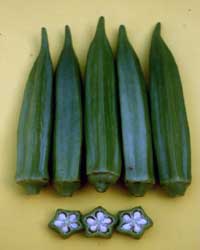Okra – Growers’ Guide

Season
Okra is vegetable Tropical zone. Best rainy, temperature (20-30 C).
Soil
Can grown in many type soil, Best is sand loam, good irrigation, pH 6.0-6.8 To plough the soil with dry sun 7-10 days To plough the soil deep 20-25 cm. Additional manure or organic rate 0.5-1.0 ton/rai fertilizer 15-15-15 or 16-16-16 rate 35-40 Kg./Rai soil to cover up plot wide 100-120 cm. high 30 cm. / plot.
Agriculture
Plant by seed 3-4 seeds/ hole, space 80-100 cm. 2 row / plot open water in to plot After planted 12-15 days select 1 plant/ hole.
Fertilizer
1. With plough formula 15-15-15 or 16-16-16 rate 35-40 Kg./rai
2. After planted 7-10 days formula 21-0-0 rate 15-20 Kg./rai
3. After 2 time always 15-20 days formula 12-24-12 or 15-15-15 rate 40-45 Kg./rai
Disease Important
Anthracnose, Leaf spot, Pot spot, Yellow mosaic
Insect Important: Cotton Leaf Worm, Thrips, Cotton Leafhopper,White Fly
Maturity
45-55 days.
It may be prepared like asparagus, sauteed, or pickled, and it is also an ingredient in various stews and in the gumbos of the southern United States; the large amount of mucilage (gelatinous substance) it contains makes it useful as a thickener for broths and soups. The fruit is grown on a large scale in the vicinity of Istanbul. In some countries the seeds are used as a substitute for coffee. The leaves and immature fruit long have been popular in the East for use in poultices to relieve pain.
